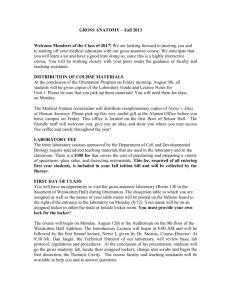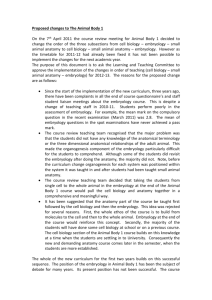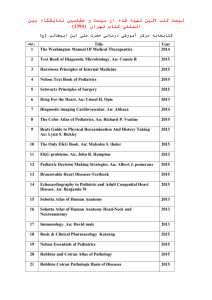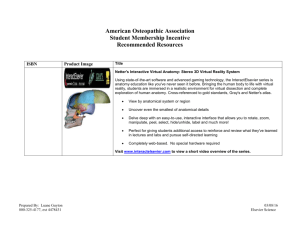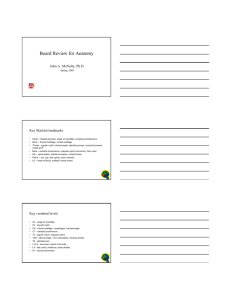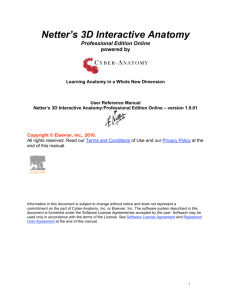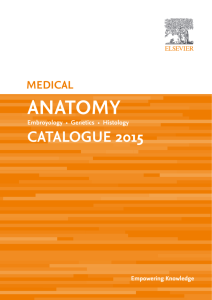HUMAN ANATOMY AND DEVELOPMENT: MAJOR TEXTS
advertisement
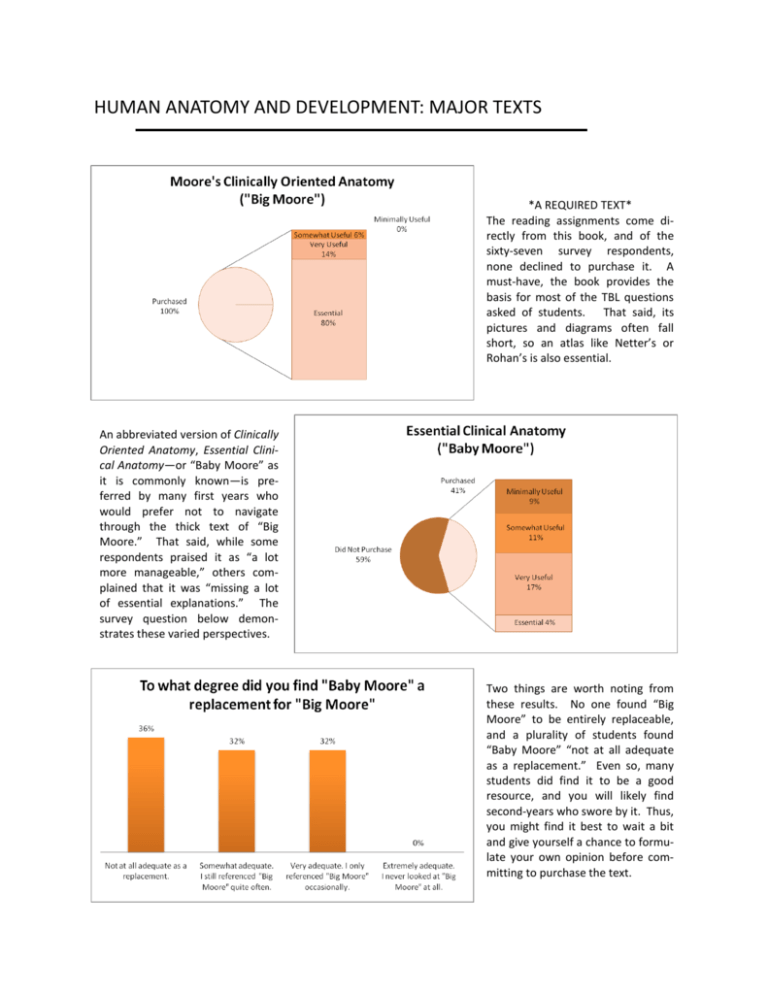
HUMAN ANATOMY AND DEVELOPMENT: MAJOR TEXTS *A REQUIRED TEXT* The reading assignments come directly from this book, and of the sixty-seven survey respondents, none declined to purchase it. A must-have, the book provides the basis for most of the TBL questions asked of students. That said, its pictures and diagrams often fall short, so an atlas like Netter’s or Rohan’s is also essential. An abbreviated version of Clinically Oriented Anatomy, Essential Clinical Anatomy—or “Baby Moore” as it is commonly known—is preferred by many first years who would prefer not to navigate through the thick text of “Big Moore.” That said, while some respondents praised it as “a lot more manageable,” others complained that it was “missing a lot of essential explanations.” The survey question below demonstrates these varied perspectives. Two things are worth noting from these results. No one found “Big Moore” to be entirely replaceable, and a plurality of students found “Baby Moore” “not at all adequate as a replacement.” Even so, many students did find it to be a good resource, and you will likely find second-years who swore by it. Thus, you might find it best to wait a bit and give yourself a chance to formulate your own opinion before committing to purchase the text. *A REQUIRED TEXT* Grant’s provides the instructions for the dissections. Because the anatomy lab is stocked with copies of the dissector, however, you will not need to use it directly in lab. It is primarily meant to help students prepare in advance for dissections. With its helpful diagrams and clinical correlates, many students found it useful in other ways. One respondent suggested “reading Grant’s before reading ‘Big Moore,’” and another found it “good for studying for the practical.” HUMAN ANATOMY AND DEVELOPMENT: ATLASES *A REQUIRED TEXT* A medical school staple, Netter’s Atlas contains painted anatomical prints designed to elucidate structures and relationships. To better serve the needs of students, Netter deliberately used bright, strongly contrasting colors in his paintings. This feature is regarded by many as a strength that clarifies and aids memorization, but for the student looking for a more realistic approach, Rohen’s might be a better resource. *A REQUIRED TEXT* Rohen’s provides the major alternative to Netter’s Atlas, though many students purchase both. Instead of paintings, Rohen’s contains actual images of dissected cadavers, making it a useful resource in a labcentered course. One second-year remarked, “It allowed me to spend less time in the lab and more time in the privacy of my own home. HUMAN ANATOMY AND DEVELOPMENT: FLASH CARDS For those students who like to study from flash cards, Netter’s Anatomy Flash Cards are a good resource. And in a course that is rooted in memory and repetition, many found them to a useful study aid. These cards take images directly from Netter’s Atlas of Human Anatomy. They also contain useful clinical correlates. These cards take images from “Big Moore.” A companion resource to the course’s main text, they can also boast the advantage of having many of Moore’s “Blue Boxes” printed on the cards. *NOTE: One respondent also recommended Rohen’s Anatomy Flash Cards. HUMAN ANATOMY AND DEVELOPMENT: REVIEW BOOKS A pocket-sized reference packed with tables, clinical correlations, and Netter’s images. As its title suggests, however, it is clinically oriented and contains a great deal more than firstyears are expected to know. The Netter’s-style depictions of the clinical correlations described in Moore’s “Blue Boxes” do, nevertheless, allow it to fill a niche that others books cannot. One student even found it “more useful than Netter’s Atlas,” citing the additional information it provides. The BRS review books are a favorite among medical students, and the Gross Anatomy book is no exception. Its extensive tables and review questions make it a useful resource. That said, it is a review book and not a replacement for any of the major texts. Most students use it primarily for the NBME Shelf exam at the end of the course. HUMAN ANATOMY AND DEVELOPMENT: EMBRYOLOGY TEXTS *A REQUIRED TEXT* Because most of the embryology material put on the exams comes from the lectures, many students found having a full textbook unnecessary. Still, it is a good resource, complete with extensive illustrations and clinical correlations. The book also proves useful in completing the embryo-related TBL questions. One respondent observed that “the professors pull many questions from The Developing Human.“ Even so, since there is a considerable disagreement over the utility of this book, you may prefer to wait on this one for now if you have any qualms. Two embryology texts is definitely overkill, so only look into Langman’s if you want an alternative. Langman’s is a classic embryo book and a number of second-years swear by it. It also has the added benefit of containing many of the lecture figures. HUMAN ANATOMY AND DEVELOPMENT: EMBRYO REVIEW BOOKS High-Yield Embryology is the most widely used embryology text among first-years. A review book, it concisely outlines the most important embryology material. As a review book, however, it has certain limitations. You may be forced to look elsewhere, for instance, for more complete explanations on certain topics. BRS Embryology, written by the same author as High-Yield, coves the same content but in more detail. Additionally, like the rest of the BRS series, it includes a number of multiple choice questions for review. PHYSICIAN’S CORE *A REQUIRED TEXT* Required for the Physical Exam component of the class, Bates is one of the must-haves of first year. Included with the book comes a CD that demonstrates the elements of the physical exam outlined in the text. Described by one second-year as “absolutely required for the course,” it’s a safe bet to buy. There is no rush on this one though, since the Physical Exam component has been moved to the second half of the year. This book applies to the Medical Interview component of the course, which, like the Physical Exam, has been moved to the second half of the year. Readings from the text were assigned before attending small group sessions. Note: Though the book was required reading last year, its role in the curriculum is currently being re-evaluated. Required last year for the Ethics, Humanism, and Professionalism module, the book comprises a collection of essays on a range of ethical issues. A number of its chapters were assigned for reading. Note: Though the book was required reading last year, its role in the curriculum is currently being reevaluated. MOLECULAR AND GENETIC MEDICINE *A REQUIRED TEXT* Lippincott’s provides background for the Biochemistry portion of the course, which represents a majority of the content covered in MGM. Because the course is so lecture oriented—the very opposite of HAD— students reported that they did fine without it. Except in preparation for the occasional TBL session, these students found the text “not very useful.” At the same time, those students who valued additional background and outside clarification characterized the text as “essential” and a “fantastic source of learning.” *A REQUIRED TEXT* Thompson & Thompson serves as a resource for the Genetics presented in the class. But because the lectures are so self-sufficient and because Genetics is a relatively small component of the course (really only emphasized during the first Unit last year), few found it very helpful. Only 11% of respondents found it to be useful at all. Like most review books, BRS Biochemistry and Molecular Biology is primarily useful for Shelf preparation. Written with the outline format and accompanying review questions that characterize the series, the book includes a number of subjects that receive scant attention from MGM but do appear in the Shelf. Some second years warned against using the resource to learn the material during the course, and a number of respondents complained of errors in the text.
